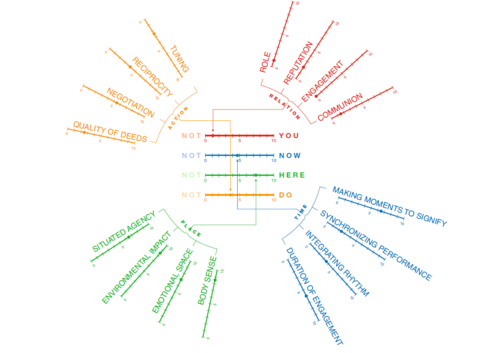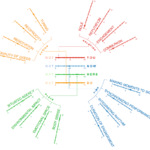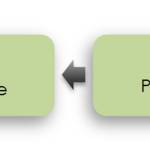Natural presence is what mainly comes to our minds when referring to “presence”, i.e. being physically present in a real environment or, as Nevejan & Brazier (2015) mention, being present with a breathing body and a heart that beats. However, presence has acquired new dimensions nowadays, which are not only related to the previous interpretation. The ever spreading internet and the tsunami of technological advances of our times have created new and totally different types of realities and virtual communities where human activities, communication and interaction are possible to take place simultaneously and over distance. Presence as a term has therefore been expanded in order to include virtual presence, describing people being present in these new realities (Nevejan & Brazier (2015).
A similar transition era is also visible in the world of education; online or distance learning with the contribution of the newly developed technological means, is gradually gaining more and more ground, introducing new ways of interaction among the participants. A change in the way knowledge is being produced, distributed and exploited in the island of Texel in order to meet the goal of a 100% sustainable Texel by 2056, is strongly related to this new dimension of presence; understanding and analyzing its main features is essential in order to design a “teach your own” sub-system. For achieving a self-sustained Texel we need to spread the knowledge about the importance and benefits of sustainability, in order to spread knowledge we need active participation of all groups and parties benefitted (students, teachers, parents, municipality etc.) and for creating a successful participatory system we need to design the presence of Texelaars and all actors involved (figure 1).
Figure 1. Steps on the “teach your own” sub-system towards a sustainable direction
The strong effect of presence in the “teach your own” sub-system is also supported by the key notions that guide the design of presence according to Nevejan & Brazier (2015). More specifically, the first two notions, “being here” and “being there”, are the main pillars of our future design; “being here” while “being there” could summarize one of the main elements of the “teach your own” system, which is to effectively replace physical presence with virtual presence, to facilitate distance interaction and reassuring functionality within the system. Establishing a convincing sense of “being there” is a precondition for active and enthusiastic participation of the virtual community’s members. Of course the evolution of technological artefacts will define whether or not this could be successful in 50 years from now. The development of graphics and 3d effects for example seems really promising at the moment, however the rules and the processes within this new environment are a matter of a well-thought-out design of presence. Reliability, validity, sensitivity, robustness, non-intrusiveness, and convenience are criteria to which the literature mentions (Nevejan & Brazier 2015) when referring to such a design. Finally it could be said that the starting point for α participatory system should be merging of being here and being there or the merging of realities, the 3rd key notion of the value of presence.
“Being here” gets the most attention in our case: we want youngsters to stay in the island after high school and be able to attend university studies instead of being in front of possible dilemmas “leave the island or stay on the island”. Texelaars love and are proud of their island; maintaining their enthusiasm and the reassuring their physical presence provides us with human power able to facilitate a sustainable transition of a sub-system which they are part of. Becoming aware of the “here” and “now”, i.e. imagining and anticipating what could happen or what would the benefits for themselves be – in our case, the benefits of a sustainable transition –, is all what “sense” or presencing is about, according to C.Nevejan and F.Brazier (2015). The same idea is supported by Venhoeven, Bolderdijk and Steg (2013) analysis about how pro-environmental behaviour can both thwart and foster well-being. They conclude that in order for a pro-environmental behaviour to result in increasing of well-being, it is necessary that the users must be convinced that it is the right thing to do and feel stimulated by its concept rather than being forced to do it through obligatory laws.
The strong effect of presence in the “teach your own” sub-system is also supported by the key notions that guide the design of presence according to Nevejan & Brazier (2015). More specifically, the first two notions, “being here” and “being there”, are the main pillars of our future design; “being here” while “being there” could summarize one of the main elements of the “teach your own” system, which is to effectively replace physical presence with virtual presence, to facilitate distance interaction and reassuring functionality within the system. Establishing a convincing sense of “being there” is a precondition for active and enthusiastic participation of the virtual community’s members. Of course the evolution of technological artefacts will define whether or not this could be successful in 50 years from now. The development of graphics and 3d effects for example seems really promising at the moment, however the rules and the processes within this new environment are a matter of a well-thought-out design of presence. Reliability, validity, sensitivity, robustness, non-intrusiveness, and convenience are criteria to which the literature mentions (Nevejan & Brazier 2015) when referring to such a design. Finally it could be said that the starting point for α participatory system should be merging of being here and being there or the merging of realities, the 3rd key notion of the value of presence.
In most of the cases, we are either used to social interaction through social networks that include certain type of behaviour or to not interacting with real people at all in the other end of the line. Even if we are searching for information online, there is no interaction with others; it’s just the user and non-living articles. Online learning methods however, involve a particular relationship, an interaction with a specific role for a specific reason, which is other than socializing: a distance relationship between student and teacher. Specific communication trajectories characterize the experience of this specific personal relationship that is developed through online educational systems.
A theoretical perspective of ”performing” presence is strongly related to striving of individuals for well-being and survival through sensations, emotions and feelings, both for the themselves and for others (Nevejan & Brazier 2015). Mediate presence however creates an issue: how intense and real-like can these sensations be or how can the consequences of individual actions be felt? The interactions between the members of an educational procedure differ significantly when the real classroom environment is transformed into a virtual one: actions, answers and questions have a different impact on the learning process and how is this experienced. All the aspects of interaction that natural presence allows, such as body touch, do not exist in a virtual classroom environment. Communion, as a term describing the unique bonds and relationships among families and close friends, is also in danger of losing ground in that future situation, as it will be further explained in the following chapters. Besides, this is a part of the argumentation against such technologies and the concern that the result will be personal isolation in non-realities. Again, a well-thought-out design of presence would be responsible for setting limits and rules, in order for such risks to be avoided and a balance to be achieved.
YTPA framework (You in Unity of Time, Place and Action) by C. Nevejan and F. Brazier (2015) will be proven useful in our attempts to analyse presence and define the design space for the “teach your own” sub-system, both for the current and future situation. It focuses on the establishment of trust and it builds design space where trust is missing, according to the analysis of its 4 dimensions. The methodology will be analytically explained in the following chapters.
Figure 2. The YUTPA framework (C.Nevejan and F.Brazier 2015)
Individual interpretations
Presence
|
Team member |
Interpretation |
Comments related to Texel sub-system |
|
Alkistis |
It can refer to either natural or virtual presence. Natural needs the physically present of a body in a real environment. Virtual presence has been introduced due to technological innovations and the communication/interaction possibilities they offer through networks. |
Online learning as a tool for a sustainable transition in education in Texel has much to do with virtual presence. “Being here” and “being there” is what we need to examine, understand and design. |
|
Clara |
Presence is the feeling of being in the same place, being this place a physical or virtual environment. Creating presence is important to create trust and legitimate a certain technology (e.g. ICT) |
One challenge of 'Teach your own' is to make Texel identity present to enhance communion to the island. Through ICT and onlne learning we experience a different type of presence than when sharing a physical space: a balance between the two types of presence needs to be reached. |
|
Menno |
|
|
|
Kimberley |
|
|
Well-being
|
Team member |
Interpretation |
Comments related to Texel sub-system |
|
Alkistis |
The state of being happy. Hedonic well-being is related to maximization of pleasure. Eudaimonic well-being is related to a virtuous life and doing what is worth doing; not all desires are worth pursuing because even though some of them may yield pleasure, they would not produce wellness. |
Well-being of Texelaars is one of the desirable goals and it should become clear how a sustainable transition will contribute to it. The benefit of such a transition is not only environmental but it should induce health and prosperity for the individuals. |
|
Clara |
Each of us requires different ingredients for well-being or happiness. Similarly, each phylosophical doctrine defines well-being in different ways. Hedonists identify pleasure with well-being whereas eudaimonists find satisfaction in acting virtuously. |
We have to find how Texelaars and particularly youngsters in Texel experience well-being and happiness and identify how (self-)sustainability and the goals of 'Teach your own' can be alligned with these desires and needs. |
|
Menno |
|
|
|
Kimberley |
|
|
Pro-environmental behaviour
|
Team member |
Interpretation |
Comments related to Texel sub-system |
|
Alkistis |
It refers to the behaviour through which the environmental negative impacts by our actions are minimized.
|
Pro-environmental behaviour is a necessary intermediate stage towards achieving the 2065 goal. However, In order for Texelaars to adopt a particular behaviour, they need to be convinced about the benefits that this involves. |
|
Clara |
Advocate for the rights of the environment as part of the socio-technical system. |
'Teach your own' has the potential to educate a pro-environmental behaviour and create awareness towards sustainability. This is vital to create willingness in youngsters to contribute to 'Texel 2065'. |
|
Menno |
|
|
|
Kimberley |
|
|



